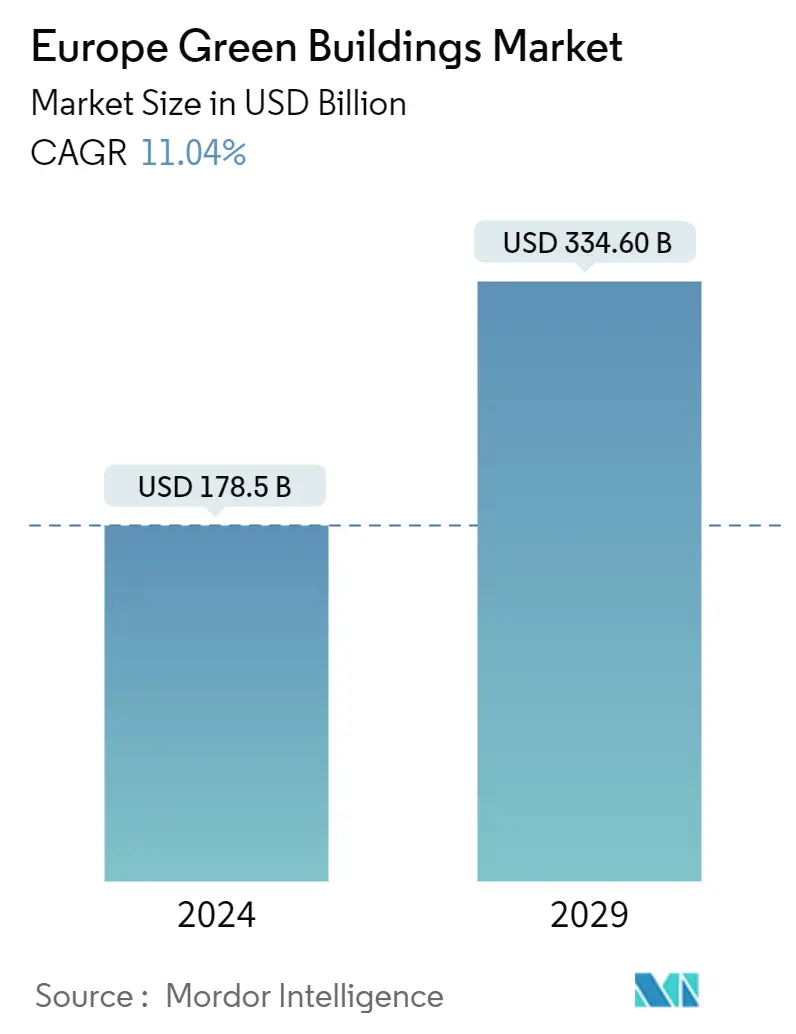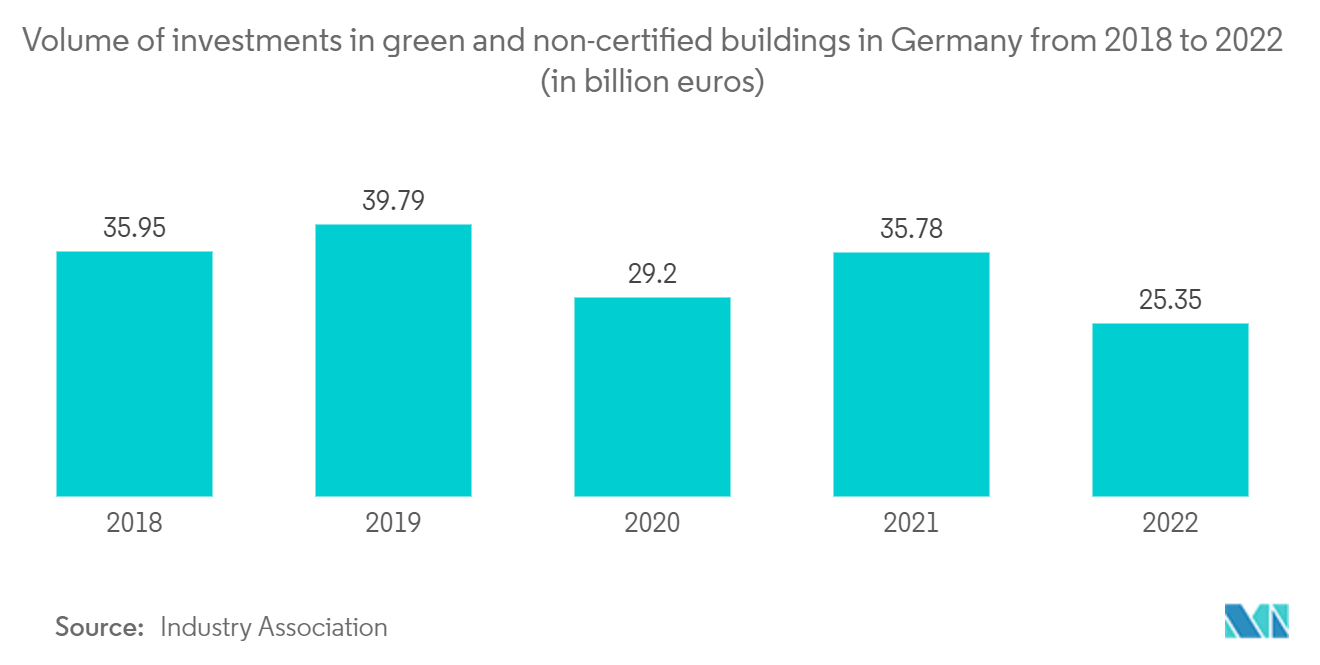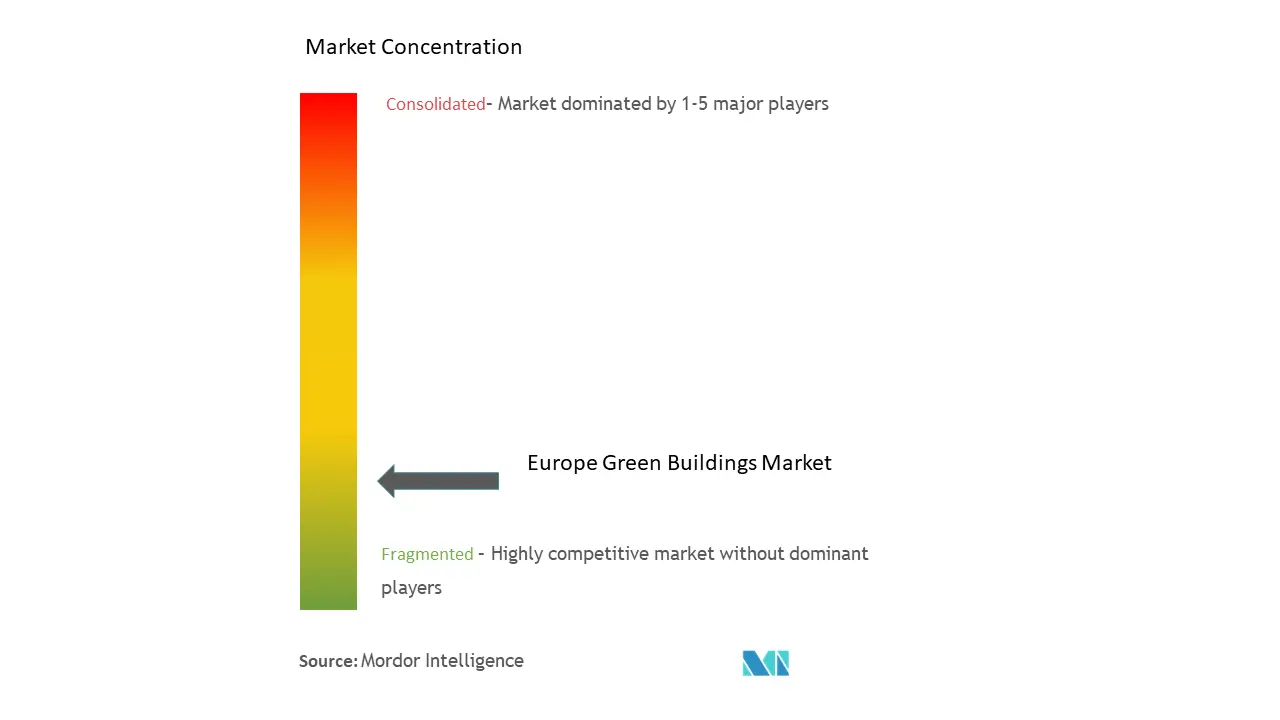Europe Green Buildings Market Size

| Study Period | 2020-2029 |
| Base Year For Estimation | 2023 |
| Market Size (2024) | USD 178.5 Billion |
| Market Size (2029) | USD 334.60 Billion |
| CAGR (2024 - 2029) | 11.04 % |
| Market Concentration | Medium |
Major Players
*Disclaimer: Major Players sorted in no particular order |
Europe Green Buildings Market Analysis
The Europe Green Buildings Market size is estimated at USD 178.5 billion in 2024, and is expected to reach USD 334.60 billion by 2029, growing at a CAGR of 11.04% during the forecast period (2024-2029).
The region strongly emphasizes sustainability and environmental responsibility. Hence, the European green building market is booming. The adoption of green building practices is driven by stringent legislation, such as the EU's commitment to achieve carbon neutrality. Integrating intelligent building technologies and increasingly using sustainable materials is an emerging trend.
Improving the environmental efficiency of buildings is increasingly important to combat climate change. Many resources are involved in building construction and maintenance, so selecting appropriate sources that will not cause further environmental damage is essential.
The building sector accounts for 40% of the overall energy consumption in the EU. Buildings account for 36% of the EU's overall greenhouse gas emissions. The Green Building Pact, which seeks to create and promote more climate-tolerant buildings through better insulation and energy efficiency, has been established by the EU.
The overall objective of the Pact is to double by 2030 the number of building refurbishments across the EU, which means that 35 million buildings will be modernized.The EU has set a target of reducing buildings' greenhouse gas emissions by 60% by the end of the decade and ensuring buildings are fully decarbonized by 2050.
German climate tech startup Purpose Green has raised a EUR 3.3 million (USD 3.55 Million) funding round to expand its presence in the German market, further develop its offering, and add more ESG, climate, and building expertise to its team.
Europe Green Buildings Market Trends
Increase in Non-residential Market
There is a wide range of different typologies in the nonresidential sector. This includes wholesale and retail (28% of the total), offices (23%), educational (17%), hotels and restaurants (11%), hospitals (7%), sports facilities (4%), and other buildings (11%) such as warehousing, transportation and garage buildings, agricultural (farms, greenhouses) buildings, garden buildings.
The diversity of typologies in this sector presents a high degree of complexity regarding energy use, given that end uses like lighting, ventilation, heating, cooling, refrigeration, IT equipment, and appliances differ widely from one building category to another across different countries.
Real estate developer AFI Europe obtained the LEED v4.1 O+M certification for its AFI Cotroceni mall in Bucharest. Colliers helped the company to obtain environmental certificates. An ongoing commitment to the implementation of sustainable practices initiated during the certification process, with a requirement to renew every three years, is the LEED v4.1 Operations + Maintenance O+M certification.
The United Kingdom has set ambitious targets to combat climate change and promote sustainable development. One of the critical areas where the United Kingdom is focusing its efforts is in the building and renewable energy sectors.
The UK's targets for sustainable building and renewable energy are amongst the most ambitious in Europe, where it currently ranks 6th when it comes to wind and solar power production. Several other European countries have set more ambitious targets. For instance, Sweden aims to reach net zero emissions by 2045, and Denmark aims for 100% renewable energy production by 2030.
Hence, the non-residential sector in Europe can potentially be a significant driver of the green buildings market by increasing demand for sustainable construction, adapting green practices, and collaborating for further innovations. the Europe can create a thriving market for environmental responsible living spaces contributing to a greener future.

Germany's Strong Demand for Green Buildings
Some of the world's most impressive sustainable architecture and eco-friendly buildings can be found in Germany. The country has made significant progress in creating a greener future, from innovative design to energy-efficient construction techniques.
Creative and environmentally conscious designs can be seen in the country's commitment to environment-friendly architecture and sustainable building materials. From office complexes to residential homes, Germany's green buildings showcase the integration of energy-efficient systems, passive solar design principles, and non-toxic finishes.
One noteworthy example is the EDGE Suedkreuz building in Berlin, certified in 2022 as Germany's most sustainable building by the German Sustainable Building Council (DGNB). It is one of the most significant buildings of its kind in Europe, thanks to its modular hybrid timber construction. With a DGNB Platinum rating, the EDGE Suedkreuz utilizes a range of eco-friendly features, including a carbon-capturing facade, biophilic atrium, and energy-efficient systems.
The development of Solarsiedlung and Sonnenschiff in Freiburg. These projects show how, through integrating Green Infrastructures in Urban Plans, Germany creates sustainable communities. Solarsiedlung, or solar settlement, is a residential neighborhood that uses the sun's energy for electricity and heating.
In 2022, most of the investments in green buildings in Germany were for office space. Logistics was the end use with the second biggest share of green building investments. There was almost 1.5 billion euros of green building investments for logistics, and roughly EUR 150 million for hotels. In 2022, the investment in green buildings in Germany made a significant share of the overall investment.
The German government is taking several steps to boost the green building market driven by its commitment to its sustainability and environmental protection. By implementing these initiavtes the Germany is aiming to establish as a global leader in sustainable construction.

Europe Green Buildings Industry Overview
The European green buildings market is fragmented due to the increasing government support for sustainable housing. Governments worldwide are introducing policies and regulations to stimulate the construction of eco-friendly buildings. The demand for green buildings is also driven by increasing awareness of climate change. The environmental impact of their actions is becoming increasingly important for people, while they demand the construction of buildings in a sustainable way. Some of the key players include Bauder Ltd, AECOM, Skanska, Turner Construction, and DuPont de Nemours Inc.
Europe Green Buildings Market Leaders
-
Bauder Ltd
-
AECOM
-
Skanska
-
Turner Construction
-
DuPont de Nemours, Inc.
*Disclaimer: Major Players sorted in no particular order

Europe Green Buildings Market News
- December 2023: UBM Development received a steady stream of preliminary building permits in Munich. The initial building permit for the commercial project “Timber Works” developed by UBM in Munich is legally binding. Planned with a timber hybrid design, the building will be constructed on a plot of land of approx. 6,500 m2 on Pelkovenstraße 148 will offer over 9,650 m2 gross floor area.
- October 2023: With an eye on 2045, Germany earmarks a record EUR 57 billion for green infrastructure, signaling a bold step toward a sustainable future. Berlin hopes to shore up the hydrogen industry with EUR 18.6 billion (USD 19.9 billion) as part of its plan to transition to renewables. Regarding transportation, the fund will provide some EUR 12.5 billion (USD 13.3 Billion) to Germany's rail network between 2024 and 2027.
Europe Green Buildings Market Report - Table of Contents
1. INTRODUCTION
- 1.1 Study Deliverables
- 1.2 Study Assumptions
- 1.3 Scope of the Study
2. RESEARCH METHODOLOGY
3. EXECUTIVE SUMMARY
4. MARKET INSIGHTS AND DYNAMICS
- 4.1 Market Overview
-
4.2 Market Drivers
- 4.2.1 Need for Reducing Environmental Impact of the Construction Sector
- 4.2.2 Support from Government Policies
-
4.3 Market Restraints
- 4.3.1 Complications Related to Certification and Permits
-
4.4 Market Opportunities
- 4.4.1 Large-scale Renovation Drive in Europe
- 4.5 Value Chain/Supply Chain Analysis
-
4.6 Porter's Five Forces Analysis
- 4.6.1 Threat of New Entrants
- 4.6.2 Bargaining Power of Buyers/Consumers
- 4.6.3 Bargaining Power of Suppliers
- 4.6.4 Threat of Substitute Products
- 4.6.5 Intensity of Competitive Rivalry
- 4.7 Impact of Covid-19 on the Market
5. MARKET SEGMENTATION
-
5.1 By Product Type
- 5.1.1 Exterior Products
- 5.1.2 Interior Products
- 5.1.3 Other Product Types (Building Systems, Solar Systems)
-
5.2 By Application
- 5.2.1 Residential
- 5.2.2 Office
- 5.2.3 Retail
- 5.2.4 Institutional
- 5.2.5 Other Applications
-
5.3 Geography
- 5.3.1 Germany
- 5.3.2 United Kingdom
- 5.3.3 France
- 5.3.4 Spain
- 5.3.5 Italy
- 5.3.6 Rest of Europe
6. COMPETITIVE LANDSCAPE
- 6.1 Market Concentration Overview
-
6.2 Company Profiles
- 6.2.1 Bauder Ltd
- 6.2.2 AECOM
- 6.2.3 Skanska
- 6.2.4 Turner Construction Company
- 6.2.5 DuPont de Nemours Inc.
- 6.2.6 Wienerberger
- 6.2.7 Alumasc Group PLC
- 6.2.8 Forbo International SA
- 6.2.9 HOLCIM
- 6.2.10 Kingspan Group PLC*
- *List Not Exhaustive
- 6.3 Other Companies
7. MARKET OPPORTUNITIES AND FUTURE TRENDS
8. APPENDIX
** Subject To AvailablityEurope Green Buildings Industry Segmentation
Green buildings are integral to creating sustainable and efficient structures, impacting design, construction, maintenance, and renovation. They are known for their high energy efficiency and utilization of renewable waste sources. These materials encompass various options, including mycelium, hempcrete, recycled plastic, straw bales, bamboo, wood, rammed earth, timbercrete, and grasscrete, offering eco-friendly alternatives for construction.
A complete background analysis of the European green buildings market, including the assessment of the economy and contribution of sectors in the economy, market overview, market size estimation for key segments, and emerging trends in the market segments, market dynamics, and geographical trends, and COVID-19 impact, is covered in the report.
The European green buildings market is segmented by product type (exterior products, interior products, and other product types (building systems, solar systems, etc.)), application (residential, office, retail, institutional, and other applications), and geography (Germany, France, United Kingdom, Spain, Italy, and Rest of Europe). The report offers market size and forecasts for the Europe green buildings market in value (USD) for all the above segments.
| By Product Type | Exterior Products |
| Interior Products | |
| Other Product Types (Building Systems, Solar Systems) | |
| By Application | Residential |
| Office | |
| Retail | |
| Institutional | |
| Other Applications | |
| Geography | Germany |
| United Kingdom | |
| France | |
| Spain | |
| Italy | |
| Rest of Europe |
Europe Green Buildings Market Research FAQs
How big is the Europe Green Buildings Market?
The Europe Green Buildings Market size is expected to reach USD 178.5 billion in 2024 and grow at a CAGR of 11.04% to reach USD 334.60 billion by 2029.
What is the current Europe Green Buildings Market size?
In 2024, the Europe Green Buildings Market size is expected to reach USD 178.5 billion.
Who are the key players in Europe Green Buildings Market?
Bauder Ltd, AECOM, Skanska, Turner Construction and DuPont de Nemours, Inc. are the major companies operating in the Europe Green Buildings Market.
What years does this Europe Green Buildings Market cover, and what was the market size in 2023?
In 2023, the Europe Green Buildings Market size was estimated at USD 158.79 billion. The report covers the Europe Green Buildings Market historical market size for years: 2020, 2021, 2022 and 2023. The report also forecasts the Europe Green Buildings Market size for years: 2024, 2025, 2026, 2027, 2028 and 2029.
Europe Green Buildings Industry Report
Statistics for the 2024 Europe Green Buildings market share, size and revenue growth rate, created by Mordor Intelligence™ Industry Reports. Europe Green Buildings analysis includes a market forecast outlook for 2024 to 2029 and historical overview. Get a sample of this industry analysis as a free report PDF download.



